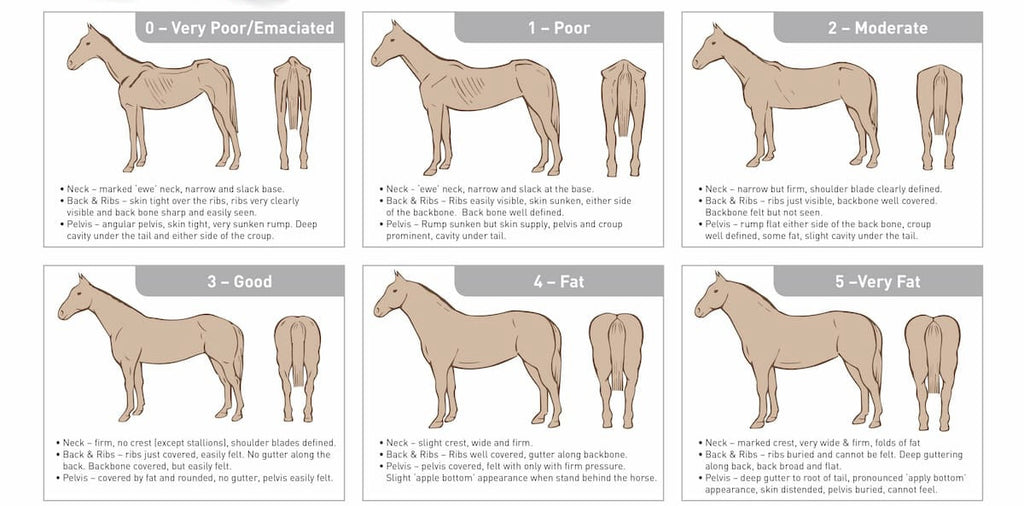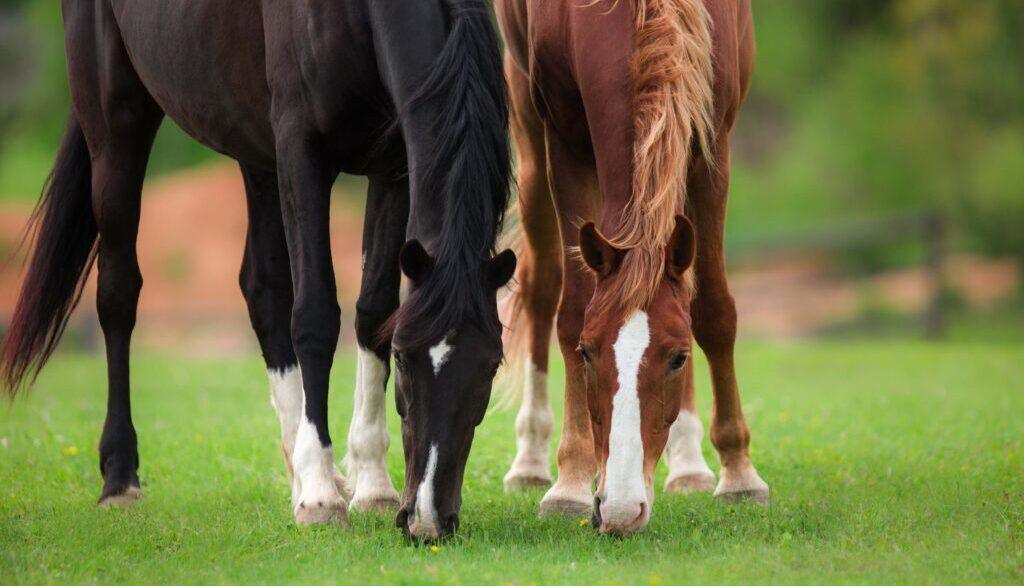Laminitis & Weight Management In Summer
Share
Summer is a welcomed season by most, but no more so than us horse owners who have spent months battling through a lack of daylight, freezing temperatures, cold howling winds and the muddiest of conditions. For some horse owners, however, the summer brings a feeling of dread as the lush green grass grows: their horses gain weight and become more at risk of developing laminitis.
In their natural habitat, horses would lose weight throughout the autumn and winter months and gain weight again in spring and summer. Therefore, the arrival of the lush green grass throughout the summer typically wouldn't have caused any problems for the horse. It would have been a much-welcomed source of energy and nutrition after a long hard winter where the horse would have used up all their previous fat and energy stores.
Over the years, horse owners have unintentionally altered this natural balance by creating a management system where it is more common to rug up, feed, and stable our horses over the winter months. In doing so, we believe we are being kind, however, the process of natural weight loss for the horse gets lost. So, our horses go into the summer nice and plump with no safety buffer against the impeding weight gain from the lush green grass, and this is why so many horses succumb to laminitis.
What is Laminitis
Laminitis is an excruciatingly painful condition affecting sensitive laminae tissues in the horse's hoof. As the disease progresses, these laminae stretch and weaken, enabling the pedal bone to rotate and move within the hoof. In extreme cases, the pedal bone will drop through the sole of the horse's foot, in which case euthanasia is often unfortunately the only treatment option to end the horses’ suffering.

According to the British Horse Society, Laminitis affects 1 in 10 horses each year, and one of the most significant risk factors for this disease is obesity. Therefore, to reduce your horse or pony's risk of getting laminitis, you must maintain them at a healthy weight. Studies have reported that between 20 – 45% of the equine population is overweight or obese, and feedback from vets and equine nutritionists suggests that this figure could be considerably higher. Reports also indicate that many horse owners underestimate horses' body fat scores, which results in them identifying horses as thinner than they are—leaving it too late to take control of their horse's diet and avoid this horrible disease.

Managing your horse’s weight isn't always easy. It can be tricky to balance your horse's diet to ensure it has enough fibre content without promoting weight gain. Horses have evolved to spend most of their time eating, and most do so for around 18 hours every day. During this time, a horse will consume 2 to 2.5% of its body weight in forage. However, many horses and ponies will consume much more than this, perhaps even twice the suggested amount, if left to their own devices in a good pasture!
Here are a few ways you can help your horse lose or maintain a healthy weight this summer:
Record Your Horse’s Weight
Firstly, note your horse's weight using a weight tape and monitor said weight by re-checking it every two weeks. Graph plotting your results and taking pictures and videos is a helpful way to monitor your horse's progress and help identify any changes. Images are also beneficial to show our nutritionists if you want more advice on what body fat score they'd give your horse.

Be Realistic
Aim to feed your horse no less than 1.5% of its body weight. Healthy weight loss for a horse is between 0.5 – 1% of its body weight per week. If a 500kg horse should be 450kg, it will take 5.5 months to get there at 0.5% weight loss per week and 2.25 months at a rate of 1% body weight per week. It's also essential to bear in mind lots of other factors will help contribute to the speed of your horse's weight loss, such as temperature, amount and type of exercise each week.
Consider Forage Quality
The type and quality of forage fed are also essential points to consider. Typically, we want the best source of forage. However, when trying to get your horse to lose weight, it is better to feed them a more significant amount of lower-quality forage rather than restrict them to less high-quality forage.
Restrict Access to Grazing
If possible, keep your horse stabled as much as you can. This way, you can get complete control over what they eat, and it is the most effective way to promote weight loss as the grass is usually the most excellent source of energy and sugar in the horse's diet. If stabling your horse isn't an option or your horse still requires turnout for other medical reasons, try to graze them on the barest pasture possible or consider purchasing a grazing muzzle to help restrict their access to grass. Avoid daytime turnout. From the moment the sun rises, the sugar levels in the grass start to increase, so to help your horse lose weight, we recommend turning them out overnight from around 10 pm – 6 am, when the sugar content in the grass is at its lowest.
Make Forage Last Longer
The aim is to keep the period your horse doesn't have access to forage as short as possible. Once you have calculated the daily amount of forage your horse requires, try to divide it into as many small meals as possible throughout the day. Opt to soak your hay as this will reduce its sugar content, encouraging weight loss. If you are splitting forage up into haynets, use small nets with multiple little holes rather than giant nets or ones with larger holes. Naturally, this will slow your horse's intake of forage and deter you from filling the nets too full. If you want your horse to eat off the floor, consider using a Hayball, as this will enable a slower intake of forage while allowing your horse to eat from a more natural position. Whether you opt for nets or a hay ball, don't forget to weigh them all to help monitor your horse's calorie intake accurately.
Increase Exercise
Just as is true for humans, to encourage our horses to lose weight, we need to increase their energy output and their amount of exercise. Try exercising your horse for at least 20 minutes a day by schooling, lunging, long-reining or hacking to help improve their waistline. Build up the work based on your horse's fitness level, and remember to keep feeding according to your horse's body weight rather than workload in this instance.

Don't Over-Rug
Avoid putting rugs on your horse to help them keep warm. Instead, let them burn off a few extra calories while keeping warm, especially if the horses have a good coat and we have mild weather.
Ensure Diet Is Balanced
Finally, as with any weight loss or management plan, it is crucial to ensure your horse's diet is balanced. Restricted access to grass reduces the energy intake of the horse's diet but also reduces the intake of essential vitamins and minerals. For this reason, we recommend speaking to your Local Feed Rep or Equine Nutritionist as they can advise on the best low-calorie balancer for your horse to help replace missing nutrients. They can also recommend a low-calorie fibre feed that will help promote gut health.







